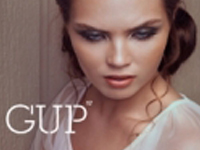
GUP
Letting Go
By Isabel Serval
With Fall Erwin has a new exhibition on display. It’s the latest sequence in a series of four: Rain, Hope, Grief, Fall. The latter of the series of four was added this September. No leather, hard-ons, or murdered kings and queens this time, but intense portraits with lots of natural light and some plants in between. Erwin Olaf has travelled a long way as an artist since he began taking pictured almost three decades ago and says that he is now, finally, learning to let go.
Olaf is known for generating awe and amazement among his public by touching often tabooed subjects like (homo)sexuality, human deformities or even bloodshed. His photographs are composed and styled to the finest detail and the person in them serves to communicate Olaf’s mental picture. This is exactly what makes him the absolute opposite to a photographer like Rineke Dijkstra, the two of them probably being the biggest contributors to the contemporary international arena of art photography these days. Dijktra captures a picture of reality, and Olaf- who actually studied journalism rather than photography- does everything but that. “I am genuinely annoyed that all this ‘normal’ stuff around these days,” he says. In his youthful attempts to grasp a part of the real world as a photojournalist, features of reality distorting his image frequently bothered him. “There’s always something in a way, like a lamppost or someone with the wrong color jacket.” This itch to manipulate the setting is what pulled him into advertising. “I reality quite boring because everyone can see it, but what I want others to see is unique.”
What Olaf never fails to attempt, whether working for Elle magazine, shooting a Diesel commercial or whether it’s autonomous work, is to lift mormality to something higher. This has sometimes been perceived as shock-art, and sometimes not as art at all. “Skinny supermodels aren’t normal, that’s all fiction. But a person missing an arm, or being severly overweight, those are just features of reality. I like to shine a different light on that, I like to make normal more special.”
Rain, Hope, Grief, Fall isn’t meant to shock. It’s a portrait study of a human being and a journey through time and ideas of decades past. Rain, the first series made in 2004, featured the United States of the 1940s and 50s and was originally called Happy. “I was a bit frustrated about the political situation of the world after 9/11. Everyone seemed to believe it was the US’ own fault they were attacked, but people forget we also have a lot to thank that country for, like freedom of speech.” However, when Olaf studied the glorious fifties up close, things didn’t seem happy at all. The series show no dancing and the cheerleaders look sulky. “I was confronted with a different truth, the America of the fifties doesn’t exist anymore, if it ever did.” He changed the name to Rain. Olaf sees Rain as a grand achievement, and it coincides with the moment this composer decided to let go. “From that moment I discovered that photography can lead you the way. I hardly ever let that happen before.” Olaf’s method of directing photography as if it were a film set was rooted in insecurity about his capacities as an artist. “I still am insecure. But I [have] stopped being unhappy about it. I’m done convincing the world, I’ve shown them what I can do now.
Through Hope, Olaf takes us to the seventies in Grief. In this series he successfully seizes a lonely moment of grief, as thought the onlooker were not supposed to see. The styling has the romance that Olaf deduced from the feel he has with the late Kennedy’s. Rain, Hope, and Grief are political time travel, revealing Olaf’s world view, his disappointments, enthusiasm, and the evident emancipation of women. On the other hand, this time travel is also personal. “It’s a trip through emotions, and half way through I start to wonder what’s next. What’s going to happen now that I’m older? But the emotion became a hang-up, so I weeded it out the final part, Fall.”
Fall has a seventies feel to it, but denies emotive content with the use of a blink. “Originally I wanted to expose the sadness of hotels, but I was unsatisfied with the result. I had accidentally shot an image of model Kim Feenstra (see cover) blinking and knew this was it. That moment is an absolute non-emotion. There is no way for the viewer to what’s going on with a person when all you see is the blinking of the eyes.” Fall doesn’t tell a story, it simply shows vulnerability, youth and beauty: three of Olaf’s all time favorite things. He turns fifty next year and, despite the emphysema he is coping with, still possess his unwrinkled radiant charms. “I enjoyed photographing very young people because of the uninhibited minds and I always try to remain that way myself.”